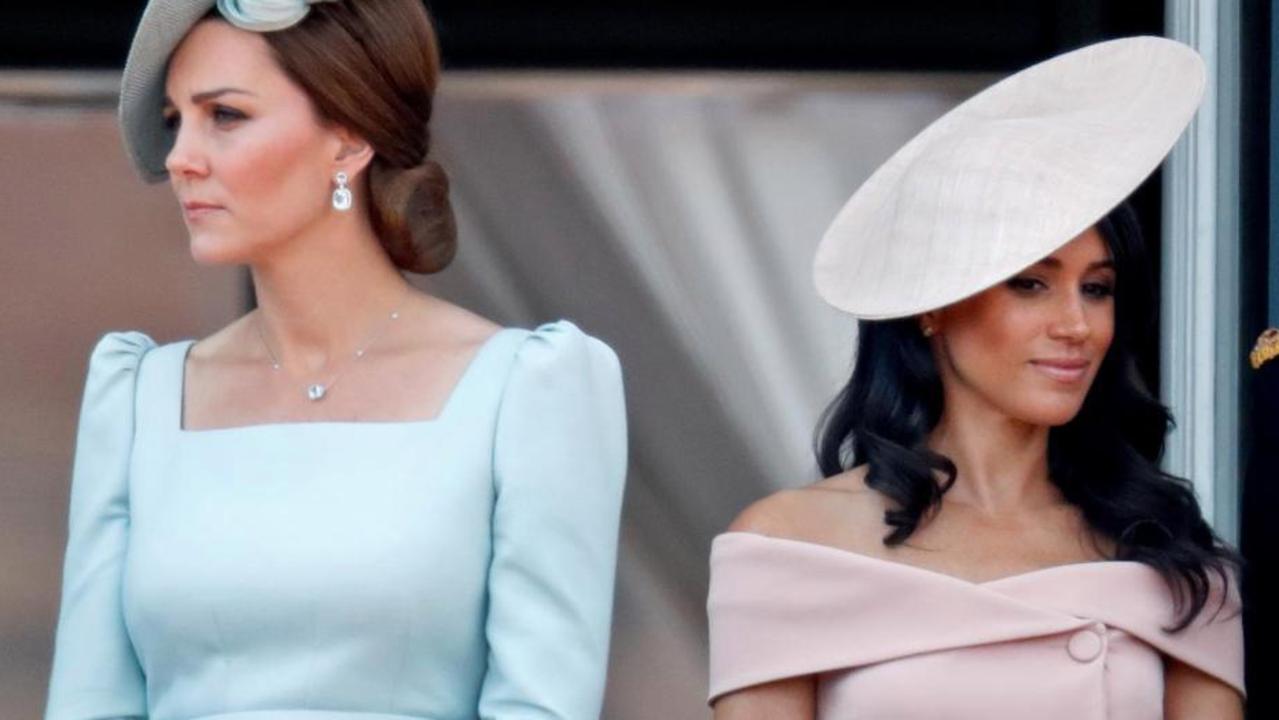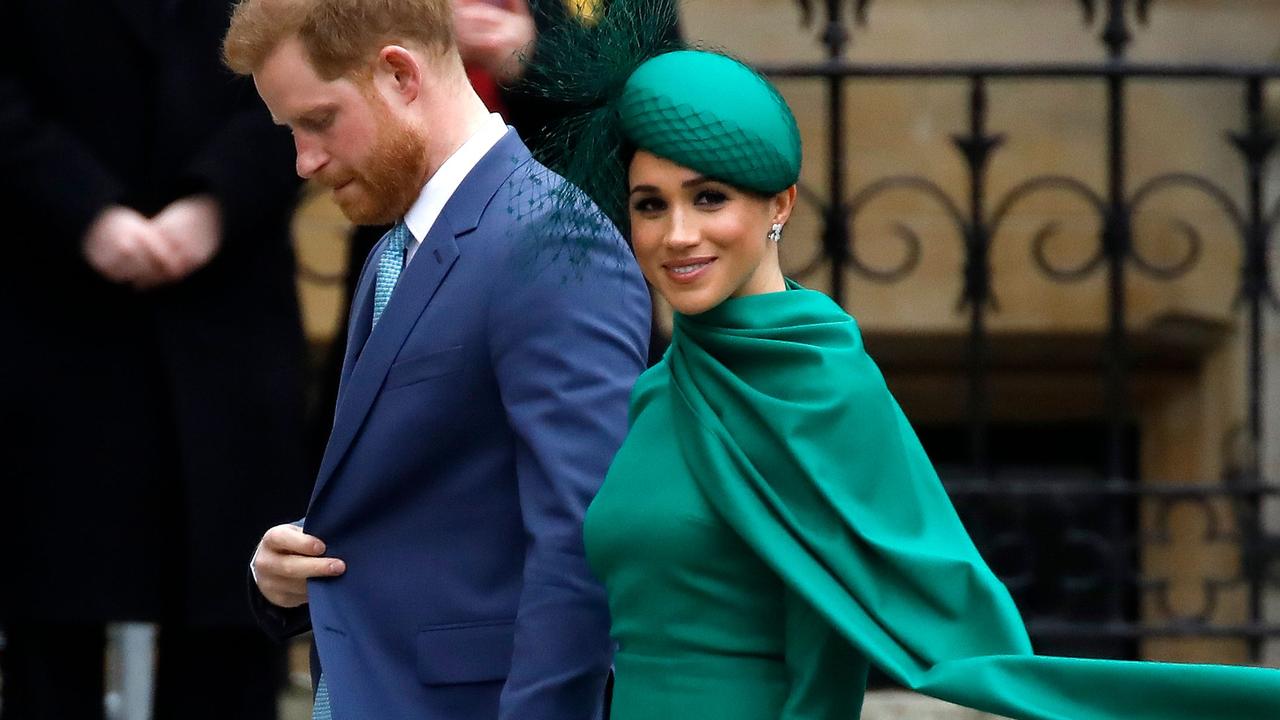Finding Freedom: Meghan and Harry’s book may cost couple $4.5 million
In just 20 minutes, Meghan and Harry managed to not only change the royal family forever but also potentially cost themselves $4.5 million a year.
COMMENT
The royal family might keep the diamond broach industry afloat and be global ambassadors for nude hosiery, but here is something that is less well known: They are also a handy diplomatic tool that the Foreign Office wields when needs be.
For example, in 1971 the Queen invited Emperor Hirohito of Japan to London for a state visit in an attempt to normalise the country’s relationship with the rest of the world after post-war isolation. Or, in 1979, the Queen visited Saudi Arabia. “What it’s all about,” The Daily Telegraph reported at the time, “is oil.”
You get the gist: Money, oil, power. When there are delicate geopolitical, economic or military concerns a foot, call in the Crown.
Things have not changed over the decades, which is why in 2016 it was Prince Charles and Camilla Duchess of Cornwall’s turn, with the pair sent off for a seven-day tour of the Middle East, including Bahrain.
From the get-go, this was a fraught, very delicate mission, with Charles facing calls to raise the country’s terrible record on human rights during the visit.
RELATED: Everything we know so far from Harry and Meghan biography

On November 8, Charles and Camilla landed in Bahrain ahead of perhaps their most high stakes mission yet.
And then the best-laid plans of Whitehall and Clarence House were blown out of the water when Prince Harry, via his press secretary, released a bombshell statement confirming he was dating actress Meghan Markle and launching an excoriating salvo at the press.
Charles who? Bahrain what?
Only a week before, on October 31, British journalist Camilla Tominey had unmasked the Suits star as the Prince’s love interest, immediately sending Fleet Street into a lather of excitement.
RELATED: Meghan, Harry book could stop their royal family return

While prior to this romance Harry seemed to have a clear type – upper crust British blondes with few professional credits – Meghan was in a league of her own.
An established actress, business woman and activist, she was American and had previously been married. (As Tominey later told the New Yorker, “When we wrote the story initially, it was kind of couched in, ‘How did he score this amazing girl?’”)
The coverage in those initial days was by and large hugely positive. Harry held a special place in British hearts. Maybe finally the little boy who had walked behind his mother’s coffin had found true love.
Then, three days after Tominey’s exclusive, the Daily Mail ran a story deeply offensively titled “Harry’s girl is (almost) straight outta Compton: Gang-scarred home of her mother revealed – so will he be dropping by for tea?”
“Markle’s social worker mum, Doria Ragland, lives in the run-down area” the story claimed.

In fact, Ragland lives in the View Park-Windsor Hills neighbourhood which is known as the “Black Beverly Hills” and is one of the wealthiest, primarily African American areas in America.
Elsewhere, one story wrote about her “exotic” DNA and on social media and social media comments laid bare a horribly virulent vein of racism.
Harry, rightly outraged, decided to take action.
Now, a soon-to-be-released biography has offered a new look into what happened when the Prince decided to suit up and white knight-style ride into the media fray, thus torpedoing his father’s Middle Eastern mission out of the media water.
In Finding Freedom, the much-hyped biography of Harry and Meghan set to be released next month, authors Omid Scobie and Carolyn Durand paint a picture of Harry outraged and driven to protect the woman he was deeply in love with.

Scobie and Durand write: “A statement from Kensington Palace condemning the press and, in the same breath, confirming Harry’s new girlfriend would all but eliminate coverage of Prince Charles’s tour of the Gulf.
“The palace decided to go ahead with the statement nonetheless, much of which was drafted by Harry himself.
“Charles learnt of it just 20 minutes before it went out. Sure enough, as soon as Harry put out his declaration, the statement dominated the news cycle.
“The team at Clarence House, which had spent months putting together Prince Charles’s tour in the hopes that it would be covered significantly, was crushed.”
Normally, one senior royal doing something to take the spotlight off another during a tour would be strictly verboten, however according to Finding Freedom, while Charles was “disappointed that his son didn’t wait for him to come back” he “understood that the situation with Meghan had reached a tipping point”.

Looking back, those 20 minutes, slim warning of a seismic disruption to his carefully calibrated overseas mission, presaged much of what was to become the Sussexes’ signature style – an independent-minded penchant for going off script, a dismissal of the status quo in favour of forging their own more radical path.
Likewise, the tone and tenor of that moment – righteous rage in the face of a cold-blooded establishment – was a harbinger of the Sussexes’ later willingness to call in the lawyers.
The Sussex years, which barely stretched from late 2017 to early 2020 (or perhaps more accurately the Sussex months – all 25 of them) rocked the royal family. Initially, the golden couple were (largely) fated by a besotted press, their passion for not only one another but clear drive and zeal for charity work giving the royal family an exhilarating and vitalising boost.
Their drive and love were, quite simply, infectious. Here finally was a Cinderella story, only this time the heroine had addressed the UN.
And then the cracks in the fairytale started to appear, with rift rumours rearing their ugly head and a steady drumbeat of critical stories about the pair taking the edge off their lustre.

In January this year came their most explosive move yet – in what some viewed as a fit of pique, they announced they were done as full-time working HRHs, even though closed door palace negotiations were still ongoing.
The move ‘blindsided’ the Queen, according to Finding Freedom. “The family is very private and bringing it into the public domain, when they were told not to, hurt the Queen,” the authors quote a senior member of the household as saying.
The palace’s reaction to the serialised extracts of Finding Freedom which have been running in the London Times, has officially been stoic silence.
Unofficially, a friend of the Cambridges has hit back at claims that Kate was unwelcoming towards Meghan, saying that the Cambridges had “rolled out the red carpet” for Meghan and “done all they possibly could”.
The great, looming unknown here is what lasting impact this biography’s release may have on the Sussexes’ relationship with the royal family.

Both the authors and Harry and Meghan have denied the Duke and Duchess sat for interviews for the book.
In May, a spokesperson for the couple said they were “relaxed” about the authors’ having spoken to people “close to them.”
On this particular issue, the Times’ royal correspondent Roya Nikkhah wrote this week: “Fans and critics alike may find those assertions hard to believe. However much the Sussexes distance themselves from the book, it reads like a ghostwritten autobiography.”
While the airing of claims that William was a “snob” and that Kate failed to show much sisterly solidarity are hardly likely to improve things between the houses of Sussex and Cambridge, there is also the possibility that soured trans-Atlantic relations could hurt Harry and Meghan in the hip pocket.

When Harry and Meghan announced they were quitting, they said they were aiming to become “financially independent” and would no longer accept the 5 per cent of their income that came from the Sovereign Grant, which was all well and good. But that other 95 per cent, I hear you ask, where does that come from?
Enter Prince Charles and the $38 million he earns every year from the Duchy of Cornwall through which he funds both the Cambridge and Sussex households to the tune of more than $4 million each annually.
While Harry and Meghan’s exit might have put them in a position to start taking on lucrative commercial gigs, the coronavirus pandemic seems to have put those plans on hold.
Thus far, the big bucks TV and publishing deals that many thought the glamorous, globetrotting Sussexes’ would easily attract are yet to eventuate.

So, while the couple might have a fortune between them (estimates put it anywhere between $30 and $60 million), until they are pulling an income, it’s likely they’ll need Charles’s largesse to keep them in around-the-clock bodyguards – and around-the-clock sunscreen to save Harry’s skin from the scorching LA sun.
Though Finding Freedom is not an “authorised or endorsed” biography, according to the Sussexes’ spokesperson, the very fact some people close to them felt comfortable to paint the royal family in such an unflattering light is hardly likely to gladden Charles’s heart.
Will this messy episode diminish the future King’s generosity towards his son?
We will now have to wait two weeks for Finding Freedom to officially hit shelves, with the prospect of more damaging revelations to come. With the title already number one in the UK on Amazon, the only people guaranteed to come out on top are the authors.
Daniela Elser is a royal expert and writer with more than 15 years experience working with a number of Australia’s leading media titles.




